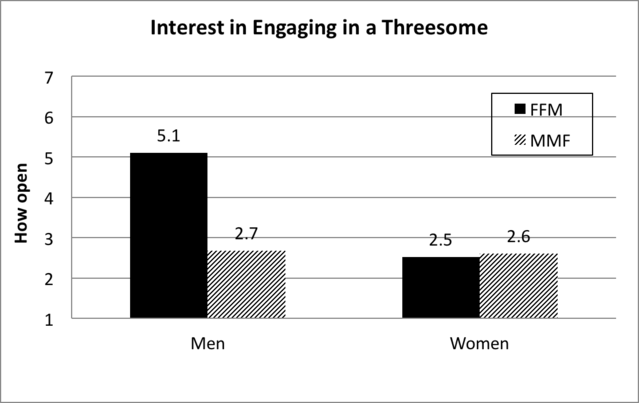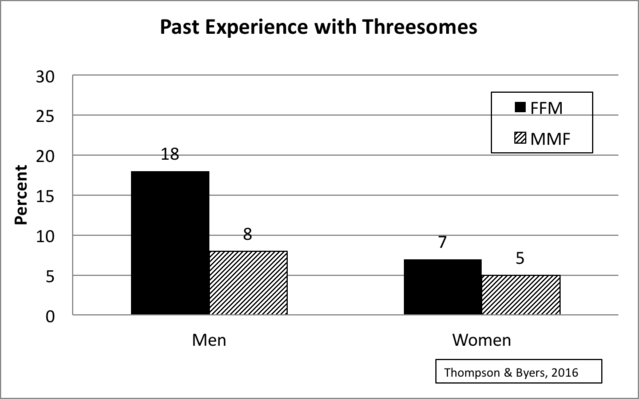Sex
Would Most People Even Want to Have a Threesome?
What do young people think about threesomes? Have they had one? Would they?
Posted March 21, 2016 Reviewed by Ekua Hagan

As threesomes and other forms of group sex become ever more visible, it becomes more important to understand people’s interest in and experiences with these alternative sexual activities. Sadly, published academic research on this topic is quite limited.
Last year, I wrote about a study that surveyed Canadians regarding their interest in and experience with a threesome with two partners of the opposite sex; that is, women’s stance on threesomes with two men (MFM), and men’s stance on threesomes with two women (FMF).
We were left wondering about men’s stance on MFMs and women’s stance on FMFs—but luckily, a new Canadian study rectifies this situation (Canadians and their sexual, uhm, enthusiasm—see this study that just came out on Canadians’ interest in kinky activities.) We now have data on both men’s and women’s interest in and experience with MFMs and FMFs, as well as their attitudes toward threesomes in general.
In this recent study in the Archives of Sexual Behavior, authors Ashley Thompson and Sandra Byers surveyed 274 heterosexual undergrads (74% women) of typical college age (18 to 24, with an average age of 20) from a midsize Canadian university. They recruited participants from introductory psychology courses and through ads placed in the student newsletter.
The anonymous online survey asked students about three aspects of threesome-related thoughts and behaviors: attitudes; interests; and past experiences, in all cases focusing on mixed-gender threesomes (i.e., a threesome in which at least one member of each gender is present). We now look at each of these in turn.
Attitudes Toward Threesomes
Young people today are much more accepting of nontraditional sexual activities, like premarital sex or casual sex, than previous generations. But no one had really asked people how acceptable they find threesomes. To gauge their attitudes, researchers asked participants to rate “engaging in a threesome” on 10 sets of adjectives (including “pure/dirty,” “desperate/fulfilled,” “pleasant/unpleasant,” “morally right/morally wrong,” “bad/good,” “worthless/valuable,” “helpful/harmful,” “normal/abnormal,” “negative/positive,” and “healthy/unhealthy”) using a scale of 1 (very negative) to 7 (very positive). The graph below shows the results:

As the graph above shows, Canadian undergrads felt relatively neutral about threesomes, on average. This average, however, masks the individual variability in the sample. Individual people’s scores on this measure ranged from 1 (very negative) to 6.5 (very positive), suggesting that the sample was made up of a mix of people with very different views of threesomes. As you might expect, men were more accepting of threesomes than women, with a one-point difference between the sexes. But differing from the stereotype that all men are crazy about threesomes, men scored on average right at the neutral mid-point of the scale. Meanwhile women scored a bit below, showing a slightly negative view of this sexual act.
Interest in Threesomes
To assess interest in engaging in different types of threesomes, researchers asked participants: “If presented with the opportunity, how interested would you be in engaging in a threesome if it involved: a) two males and a female, and b) two females and a male?” Responses could range, again, from 1 (not open at all) to 7 (very open).
Overall, 82% of men and 31% of women reported at least some interest in at least one of the threesome types—that is, they responded with a 2 or higher on either the MFM or the FMF question. These numbers are virtually identical to those found in a separate sample of U.S. undergrads over a decade ago.

As you can see from the graph above, average interest in threesomes was fairly low—only about 2.5 on the 1-to-7 scale. This was true of women’s interest in either FMF or MFM, and of men’s interest in an MFM. Perhaps not surprisingly, the sole exception was male interest in an FMF: Their openness to this particular scenario far outweighed both their own interest in an MFM and women’s interest in any kind of threesome.
A few additional questions on familiarity of partners and relationship dynamics revealed that people were just as (un)interested in a threesome if it included their romantic partner versus as they were in being the third person joining a different couple. This was true of both men and women.
Further, men preferred to have threesomes with friends or acquaintances more than with strangers; this was true whether they were to do it with their own partners or as the third person. Women also preferred friends or acquaintances if they were the third person, but women had no preference regarding familiarity of the third person if they were doing it with their romantic partner.
Past Experience With Threesomes
Finally, there was the question of whether participants had already had a threesome. Overall 24% of men and 8% of the women said they’d already had a threesome of some sort. Of those who reported at least one type of threesome, 26% reported both types, 51% reported only FMF, and 17% reported only MFM.

As the graph shows, actual experiences seemed to reflect desired experiences, with 18% of men reporting an FMF experience, compared to only 8% of men reporting an MFM, and 5% and 8% of women reporting FMF and MFM, respectively.
Of course, this pattern of results raises the question of who exactly are the women these men had all those FMFs with? It’s possible that those women were not part of the undergraduate student body surveyed here or that there’s a small group of women who provide most men their FMF experiences. But it’s also possible that men are over-reporting this behavior to make themselves appear more studly and/or women are under-reporting this behavior to make themselves appear less promiscuous.
Conclusions
Overall, it appears that threesomes are not uncommon or highly unacceptable, but they are also not especially mainstream, at least among Canadian undergrads. Most people’s interest in such scenarios was fairly low, suggesting that they might be open to it if the right opportunity presented itself, but that they were not motivated enough to actively seek it out.
Compared to women, men were more accepting of threesomes in general, and more interested in—and experienced with—FMF threesomes in particular. These gender differences are striking, but not surprising. Men are generally more sexually adventurous and accepting of nontraditional sex in all its forms than are women.
But more specifically, a threesome with two women is the ultimate fantasy of many heterosexual men, a conquest above all conquests, a fun playful party time, and twice the number of all the body parts they enjoy sexually. The same kind of threesome doesn’t necessarily have the same specific appeal to a heterosexual woman, beyond a general excitement that a group sex scenario would afford.
Where there were no gender differences—in people’s interests or past experiences—was in the MFM threesome. On one hand, you might imagine that straight women should be into this scenario more so than straight men—after all, the women get to be the center of the attention of two partners of their preferred sex. The men have to deal with the discomfort, so deeply imbued by our still-homophobic culture, of having another naked man in their presence. On the other hand, however, a threesome with two men is much more of a social taboo for women than a threesome with two women is for men; "good" girls don’t want casual sex with even one guy, let alone two. The MFM scenario also carries all sorts of physical safety and power dynamics concerns that may make women uncomfortable, concerns not necessarily facing men in FMF scenarios.
These results are far from definitive, especially given that the sample is not very representative. Nonetheless, they are telling of the thoughts and behaviors of the current generation of North American undergraduate students.
Facebook image: oneinchpunch/Shutterstock
References
Thompson, E. A., & Byers, E. S. (2016). Heterosexual young adults’ interest, attitudes, and experiences related to mixed-gender, multi-person sex. Archives of Sexual Behavior. E-pub ahead of print. doi:10.1007/s10508-016-0699-1
Hughes, S., Harrison, M. A., & Gallup, G. G. (2004). Sex differences in mating strategies: Mate guarding, infidelity and multiple concurrent sex partners. Sexualities, Evolution and Gender, 6, 3–13.




